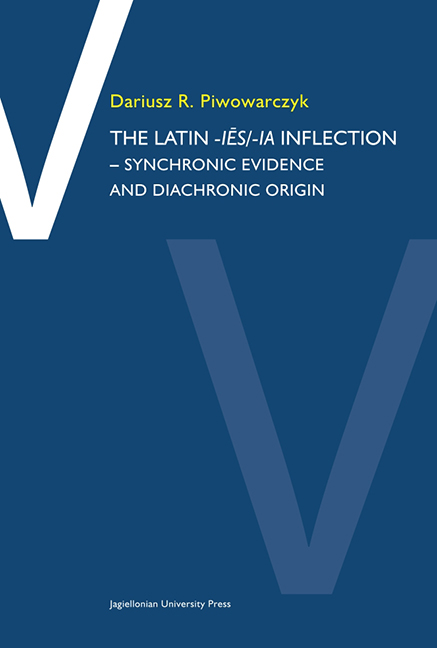Chapter one - Indo-European derivational morphology
Published online by Cambridge University Press: 16 July 2022
Summary
The word in an Indo-European language consists of a lexical morpheme (lexeme, root, abbreviated as R), a derivational one (a suffix, abbreviated as S, forming a stem with the lexical morpheme) and an inflectional one (the ending, abbreviated as E), cf. Matthews (1991: 24-60). The lexical morpheme is the carrier of semantic meaning while the derivational morpheme identifiēs the morphological class to which the word belongs (nomen agentis, nomen actionis, nomen instrumenti etc.). Finally, the inflectional morpheme identifiēs the function of the word in sentence. An example of such a formation would be the acc. sg. of the word for ‘parent,’ Proto-Indo-European *ĝénh1-tor-m̥ (R-S-E). Formations with the derivational morpheme zero are called root formations. A formation with one suffix is a primary formation whereas one with two or more suffixes is a secondary formation (cf. Fortson 2010: 83-85). Whereas it is more or less clear that the primary stem formation is governed by a set of rules within the Indo-European accent-ablaut system of paradigms (cf. Fortson 2010: 119-122), the setup of secondary formations seems less clear.
I recognize the following types of accent-ablaut paradigms in the protolanguage (cf. Schaffner 2001: 76-94, Meier-Brügger 2003: 201-218, Neri 2003: 12-43, Widmer 2004: 49-54, Weiss 2009: 257ff.):
For root nouns I recognize three types:
Furthermore I follow the opinion of Jochem Schindler (class teaching) that the terminology used for the primary athematic formations presented above should not in principle be used to the secondary types such as the thematic declension or vr̥kī́ḥ formations as it is used by Rix (1976: 121-127), Schaffner (2001: 76-94). Cf. also the similar opinion of Meissner (2005: 33).
The process of derivation, that is forming new words on the basis on the ones already existing in the lexicon, is primarily an analogical process through which a productive affix is added to an already existing lexeme thus creating a new word (cf. Matthews 1991: 61-69, Heidermanns 1996: 44). Derivation, in contrast to inflection, is generally irregular and unpredictable (cf. Heinz 1961) and the problem with the assumption whether a certain formation is productive in the language or not stumbles upon the problem of the lack of native speakers in case of arcane languages (cf. Matthews 1991: 69-81, Bauer 2001).
- Type
- Chapter
- Information
- The Latin -iés/ia Inflection , pp. 11 - 14Publisher: Jagiellonian University PressPrint publication year: 2022



